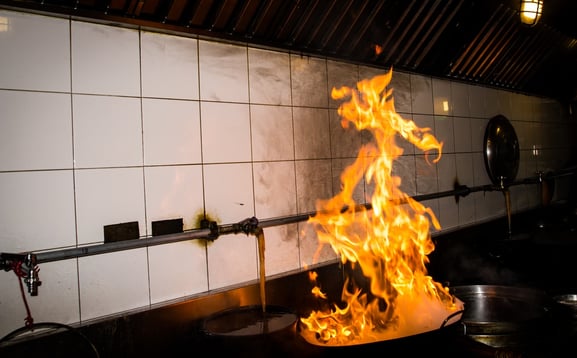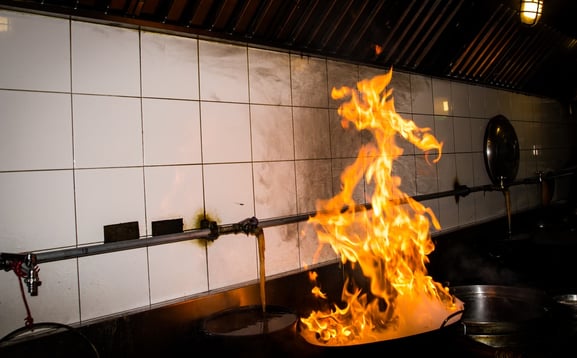As we have discussed in some of our recent articles, commercial kitchens have special requirements that must be considered by MEP design engineers. This also applies to fire suppression systems, since kitchens have more flammable substances and potential fire sources compared to most other commercial locations.
Before discussing commercial kitchen fire suppression, it is important to understand that not all fires are created equal. As there are many types of flammable substances, the resulting fires also have different properties. Fire classes in the US are summarized in the following table:
|
FIRE CLASS |
FLAMMABLE/COMBUSTIBLE SUBSTANCE OR FIRE SOURCE |
SUITABLE SUPPRESSION METHODS |
|
A |
Non-metallic solids such as wood, paper and textiles. |
Most suppression methods can be used. |
|
B |
Liquids and gases |
Stop or inhibit the chemical chain reaction that produces the fire. This is typically accomplished with dry chemical fire suppression. |
|
W |
Electrical fire |
Fire suppression methods that do NOT use conductive substances such as water. |
|
D |
Metals |
Specialized suppression methods specific to flammable metals |
|
K |
Cooking oils and fats |
Removal of oxygen supply or water mist. |
Although cooking oils and fats are technically flammable liquids (Class B), they belong to a class of their own (Class K) due to the special conditions found in commercial kitchens.
There are also European and Asian fire rating systems. There is some overlap between classes across systems, but there are also important differences. When viewing a fire class specification, also check the rating system being used.
Design a reliable fire suppression system for your commercial kitchen.
Basic Principles of Fire Suppression in Commercial Kitchens
Wet chemical fire suppression systems are typically used in commercial kitchens and the UL 300 standard requires compliance. These suppression systems extinguish fires with a combination of oxygen depletion and water-based cooling:
- The chemical agent includes an alkaline substance, which forms a soap after reacting with fats – the process is called saponification. A layer of foam forms above the burning oil or fat, cutting off the oxygen supply. Some common agents are potassium acetate, potassium carbonate, and potassium citrate.
- There is also a water content in the fire suppressant, which cools oils and fats below the ignition temperature.
Kitchen fire suppression systems are connected to equipment exhaust fans and gas supply lines. Once activated, the system stops the gas supply in addition to releasing the chemical agent; Burning fats and oils is much more dangerous if gas is released nearby. Equipment hoods are then used to remove smoke resulting from fire suppression.

Commercial kitchen fires can quickly spiral out of control unless there is effective fire suppression. Consider that kitchens are used in many types of buildings with many occupants, including restaurants, hotels and event venues. In addition to being a mandatory safety measure, kitchen fire suppression provides a practical benefit: Fires are typically extinguished quickly, before they can disrupt general kitchen operations.
What standards apply to commercial kitchen fire suppression?
In the US, the main standards for fire suppression systems in commercial kitchens are as follows:
- UL 300: Standard for Fire Testing of Fire Extinguishing Systems to Protect Commercial Kitchen Equipment
- NFPA 17A: Standard for Wet Chemical Extinguishing Systems
- NFPA 96: Standard for Ventilation Control and Fire Protection in Commercial Kitchen Operations
UL 300 standard
The UL 300 standard was developed by Underwriters Laboratories in 1994 to establish adequate fire protection requirements for modern commercial kitchen equipment. The food industry was evolving and kitchen equipment was being modernized, so fire protection requirements had to be updated accordingly. While commercial kitchens became more efficient, they also became more dangerous and fires became more difficult to control.
The main requirement of the UL 300 standard is the use of wet chemical agents to suppress fires in commercial kitchens. Other relevant requirements covered by UL 300 are the following:
- Installation of fire suppression nozzles in hoods and ducts and on individual kitchen equipment.
- Installing a manual station to activate the fire alarm located within the kitchen area.
- Automatic shutdown of the power source for all electrical and gas appliances.
- Fire suppression system inspection and maintenance: Twice a year by a licensed fire protection company.
- Cleaning and maintenance of exhaust fans and ducts: Twice a year, also by a licensed contractor. Baffle filters should be cleaned weekly or as recommended depending on the type of cooking.
NFPA 17A and 96 standards
The NFPA 17A standard applies to pre-engineered wet chemical fire suppression systems, at all stages of the project: design, installation, commissioning, operation, inspection, testing and maintenance. In general, the standard deals with wet chemical systems that use fixed nozzles and release the chemical agent with pressurized gas. The requirements provided are applicable to all wet chemical systems regardless of manufacturer differences such as component design and the specific chemical agent used.
The NFPA 96 standard provides ventilation control requirements to complement the operation of fire suppression systems in commercial kitchens. The standard covers equipment such as exhaust fans, ducts, fans and air dampers . Commercial kitchen ventilation has special requirements due to the presence of cooking ingredients, grease and oil droplets in the air.
Final Recommendations
Commercial kitchen equipment provides efficiency in cooking operations, but it also presents greater fire risks than a smaller residential kitchen. Fires caused by cooking oil and fat are in a class of their own, due to the special requirements of commercial kitchens and the risk of rapid spread.
Keep in mind that where there is a commercial kitchen, there is also a crowd of people being served. Meeting safety and hygiene requirements is of utmost importance, and the best recommendation is to work with qualified design professionals.

